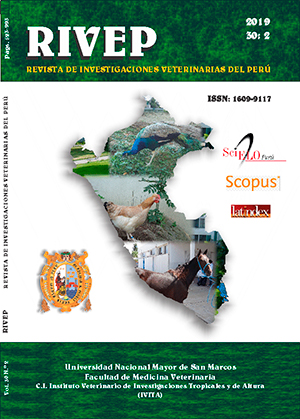Jejunal enterectomy covered with bovine pericardium xenograft in a canine model
DOI:
https://doi.org/10.15381/rivep.v30i2.16132Keywords:
enteroctomy, jejunal anastomosis, xenograft, bovine pericardiumAbstract
The aim of this study was to evaluate the alteration of the cellular components of the peritoneal lavage and to characterize the cicatricial remodelling, at the macro and microscopic level, produced by the experimental use of bovine pericardium xenograft (XPB) not treated as a lining of the end to end-jejunal terminal anastomosis in a canine model. Nine canines between 4 and 6 years of age, 15-30 kg of weight, and both sexes were randomly distributed in three experimental groups (A, B and C for a second celiotomy at 5, 10 and 30 days post-surgery) of three animals each, to which an untreated XPB was placed as a lining of the jejunal enterectomy. The results of the analysis of the cellular components of the peritoneal fluid showed a significant increase in lymphocytes, macrophages and eosinophils 30 days after the surgery and to a lesser extent 10 and 5 days after the intervention. In the macroscopic pathology, none of the groups denoted the presence of leakage, stenosis, abscesses or signs of peritonitis, nor was visualization of contraction or displacement of the XPB, but adhesion of the omentum was evident. The histopathology revealed a reaction to a foreign body of minimal to moderate, but totally compatible with life and almost surpassed 30 days after the surgery. It is concluded that the technique of jejunal anastomosis in canines coated with untreated XPB is viable and effective because it does not generate severe cellular infiltration against possible harmful cellular antigens or calcification processes. In addition, it does not alter the functions of intestinal digestion, secretion and absorption.
Downloads
Downloads
Published
Issue
Section
License
Copyright (c) 2019 Ceesar Nilthom Aguilar Guevara, Gianfranco Espil Incil, Natalia Soledad Gonzalez Gavidia, Octavio Merino Minchán, Cristina Tatiana García Barjoveanu, Diego Pier Allcahuamán Matienzo, Alfredo Delgado Castro

This work is licensed under a Creative Commons Attribution-NonCommercial-ShareAlike 4.0 International License.
AUTHORS RETAIN THEIR RIGHTS:
a. Authors retain their trade mark rights and patent, and also on any process or procedure described in the article.
b. Authors retain their right to share, copy, distribute, perform and publicly communicate their article (eg, to place their article in an institutional repository or publish it in a book), with an acknowledgment of its initial publication in the Revista de Investigaciones Veterinarias del Perú (RIVEP).
c. Authors retain theirs right to make a subsequent publication of their work, to use the article or any part thereof (eg a compilation of his papers, lecture notes, thesis, or a book), always indicating the source of publication (the originator of the work, journal, volume, number and date).










